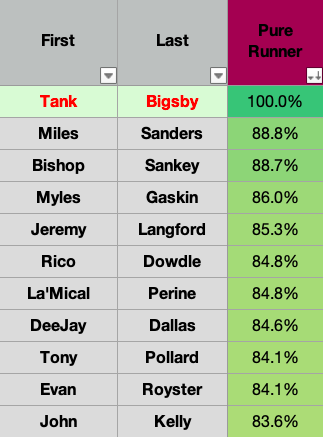This article will kick off a series in which I evaluate current college running backs solely on their ability to run the ball. I previously did the same sort of analysis focused on the 2022 rookie running back class, and you can find those articles, as well as explanations of my methodology, here and here. Otherwise, feel free to skip to the player-focused analysis below.

Auburn’s Tank Bigsby was a four-star recruit and the fourth-highest rated running back in the 2020 recruiting class. His production as an underclassman in the SEC has backed up that top-tier pedigree. As a true freshman, his 21.6-percent per-game Dominator Rating was an 81st-percentile mark among first-year running backs since 2007. At least among those who would eventually be drafted. The 25.1-percent mark he posted as a sophomore last season landed in the 69th-percentile. Let’s see how his rushing efficiency numbers stack up to that top-end production.
The Metrics
To date, Tank Bigsby has handled 361 carries in 23 career games, giving him per-game rushing volume in the 72nd-percentile. On that volume, and relative to teammates that averaged a collective 3.07-star rating as high school recruits (46th-percentile pedigree), he has averaged 0.28 fewer yards per carry than other Auburn backs. That YPC+ mark is in the 19th-percentile. His 10-yard run rate relative to those guys has been positive at 0.95-percent. But that Chunk Rate+ mark is perfectly average, landing in the 50th-percentile. As an open-field runner, Bigsby has also been fairly mediocre. His Breakaway Conversion Rate, measuring how often he converts his 10-yard runs into 20+ yard gain, is 29.8-percent (45th-percentile).
Those numbers don’t speak well to Bigsby’s potential to carry the ball efficiently in the NFL. But it’s really been a tale of two seasons thus far in his college career. As a freshman, he had 1.45 (83rd-percentile) YPC+ and 4.06-percent (80th-percentile) Chunk Rate+ marks. As a sophomore in 2021, he took a big step back. Last year, he posted negative marks in both YPC+ (-1.35) and Chunk Rate+ (-0.97-percent). These landed in the 4th and 30th-percentiles, respectively.
So What Happened?
To be honest, I have no idea. Auburn had a new coaching staff. But that didn’t have a negative effect on the ground attack overall. The team’s rushing efficiency, excluding Tank Bigsby‘s contributions, went up. In 2020, the other backs averaged a collective 4.20 yards per carry, while they averaged 6.17 in 2021. The dip is also not attributable to more difficult circumstances regarding the defenses he was facing. In 2020, he was more efficient than his teammates while facing box counts that were heavier than the ones they faced. And then he lagged behind the per carry output of his teammates in 2021 while facing lighter relative box counts. I also couldn’t find reports of any injuries sustained during last season. Though he did sustain a hip injury against Tennessee in 2020, and played three more games afterwards.
I simply don’t know the cause of Bigsby’s dip in play, but I’m here to tell you what, not why. As a freshman, he was tremendous. Given the box counts he saw, the average Bigsby carry was worth 168.8-percent the output of the average non-Bigsby carry for Auburn; good for a Box-Adjusted Efficiency Rating that would be the highest among career marks in my database. He also was more consistent than other Tiger runners, with a Relative Success Rate (which, adjusted for box counts, tells you how often a player is gaining a requisite amount of yards on his carries relative to his teammates) of 11.5-percent that would land in the 95th-percentile.
Last year, Bigsby’s BAE Rating of 82.7-percent was just a 3rd-percentile mark. And his -1.2-percent RSR was in the 34th-percentile.
On the aggregate, that gives Bigsby a BAE Rating of 101.6-percent and an RSR of 2.3-percent. Those numbers land in the 19th and 57th-percentiles, respectively.
Rushing Efficiency Score and Comps
My process combines percentile scores in the above metrics (in addition to adjustments for overall team quality and strength of opponent) to generate composite scores that quantify a player’s overall rushing efficiency profile. In a composite that uses BAE Rating and RSR, Tank Bigsby earns a 38.0 out of 100. In a composite that uses the non-box count-related metrics, he earns a 39.1. Given his abysmal 2021 season, he looks like a subpar rusher of the football thus far in his college career.
Using the same metrics that go into that second rushing efficiency composite (in addition to physical measurables), I am also able to generate similarity scores between current and past prospects as a way of formulating comps. Assuming he runs a 4.50 40-yard dash at a projected 216-pounds and just shy of 6-0 (based on this research), the following historical prospects are his most similar from a “pure runner” perspective:

I’m not sure that Bigsby is stylistically much like the Miles Sanders and Bishop Sankey types we see at the top of this list. But their rushing efficiency profiles are very similar. Here they are side-by-side:

Last Word
I’m not willing to step out on a limb and say that a guy who is a consensus top-5 running back in devy formats isn’t a good player. But I’d be steering clear of Tank Bigsby at the top of drafts. We saw in 2020 that he has it in him to run well. But the risk presented by his awful showing last season is too much for me to stomach with a premium pick.
